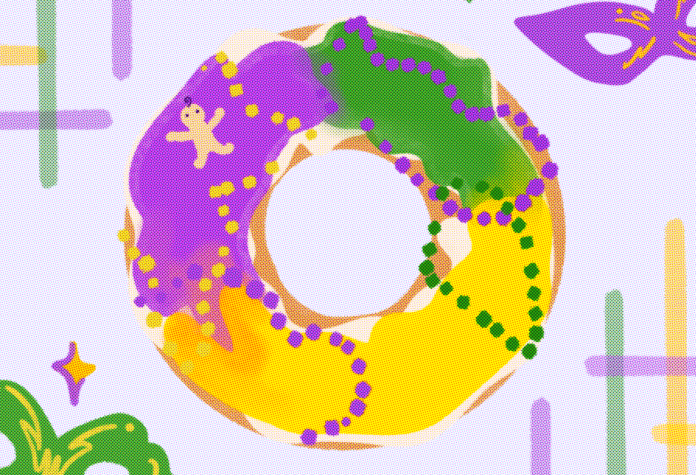Cassie Pataky
Senior Staff
On Feb. 21, 2023, Mardi Gras passed once again without much attention. Despite its popularity in certain pockets of the world, it isn’t quite as well known, or celebrated, here in Santa Barbara. So, what is Mardi Gras and how do people celebrate it?
Mardi Gras is French for “Fat Tuesday,” another name this holiday is known by. Fat Tuesday is a celebration of indulgence that precedes Ash Wednesday, the first day of Lent. During this time, many Christians fast or give up something of comfort. Mardi Gras itself is the culmination of Carnival, the season before Lent, and is the epitome of celebration and indulgence. Just as the name suggests, festival goers proudly indulge in activities such as parades, balls, and celebrations.
In the United States, the city of New Orleans is most well known for its colorful and flashy Mardi Gras celebration. In 1875, the governor of Louisiana made Mardi Gras a legal holiday.
The celebration of Mardi Gras was brought to the U.S. by French colonists who settled in the Southeastern region. French-Canadian explorer Jean Baptiste Le Moyne Sieur de Bienville, “discovered” what is now the city of Mobile, Alabama on Fat Tuesday in 1699. He proceeded to name it “Pointe du Mardi Gras.” Though New Orleans, a growing trade port, became the capital of Louisiana in 1723, Mobile remained the inspiration for the spectacular Mardi Gras celebrations.
Mardi Gras began as an Anglican and Catholic holiday, but it has since evolved into a more secular festival. Over the years, secular traditions have been added and changed so that the holiday is more inclusive. In honor of Russian Duke Alexis Romanoff, the traditional colors of Mardi Gras (purple, green, and gold) were established in 1872. They were given official meanings in subsequent years to encapsulate the wide range of participants and festivities.
A very popular tradition is wearing masks. Initially, these masks were worn to erase social and class boundaries. This way, poorer citizens could enter into the extravagant balls that were thrown.
Masks also protected the identities of the members of the krewes, the groups that organized the parades and balls and stood on the floats. The tradition of krewes began with the Masque de la Mobile, a secret society that formed in Mobile in 1704. In 1710, it was replaced by the Boeuf Gras Society, which paraded a bull’s head to signify the oncoming Lenten fast through town. However, parades were not the main attraction that they have become today. Instead, the first krewes hosted elegant society balls, which still continue today.
Because krewes began as secret societies, their membership was initially quite restrictive. At one point, only white men could become members of the secret society. Due to slavery and racism, the Black communities in New Orleans formed their own krewes, often named after Native American tribes as an homage to their help escaping slavery. Collectively, these krewes are known as the “Mardi Gras Indians.” They hold their own parade, but the main event is composed of the stand-offs that krewes (or tribes) have with each other. When two tribes pass each other, they will each make a declaration with song and dance to establish themselves as the tribe with the best craftsmanship.
Out of all the popular and unique traditions, my favorite is eating the King Cake. Traditionally, the cake consists of a rich, brioche dough, usually with a cinnamon filling, braided into a circle or a crown. The main attraction, however, is the exquisite icing and colorful decoration. Many people experiment with different fruit fillings and flavored cream cheese icings. In any version of the king cake, there is a tiny hidden baby or another small item. Whoever gets the baby in their slice is blessed with luck for the day, and they are also responsible for hosting the next party (and buying the king cake for the next party). This tradition occurs throughout all of Carnival, so people have many opportunities to eat king cake and host parties.
In 2021, the city of New Orleans officially canceled Mardi Gras as a precaution to keep everyone safe and follow COVID-19 protocols. Many krewes created their own ways for people to celebrate Mardi Gras and safely social distance. Some created scavenger hunts, others hosted drive-thru parades, and one even designed an app for people to collect redeemable prizes. Many restaurants and bakeries in New Orleans maintained traditional Mardi Gras menus available for delivery or pick up.
Though Santa Barbara doesn’t have as much glam and glitter as New Orleans, there are still ways to celebrate Mardi Gras at UC Santa Barbara. A couple of organizations host Mardi Gras celebrations, such as Court Appointed Special Advocates (CASA) and St. Mark’s University Parish. Many restaurants serve a Mardi Gras menu with traditional foods. Or, if you’re looking for a more cost-effective way to celebrate, you can always try out a traditional cajun recipe for dinner!











